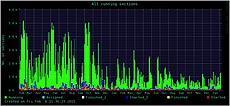Farewell, CDFGrid
 |
| This shows the jobs that have run on CDFGrid over the past 24 months. As many as 5,000 jobs could run at the same time. The level sustained over the last 12 months is anticipated to continue on FermiGrid. Image courtesy of Costas Vellidis, PPD |
For more than a decade, CDFGrid was a cornerstone of the Tevatron physics program, serving as the main computing resource for the CDF experiment. Recently the CDF data preservation team, in collaboration with Scientific Computing Division personnel, migrated their analysis efforts to Fermilab's general-purpose grid cluster, GPGrid, taking over the tasks of the experiment-specific CDFGrid. Thus on March 1, CDFGrid was retired after a long, noteworthy run.
CDFGrid was the main computing facility for all of the major results of CDF in the last 10 years and had huge impacts in the field of particle physics. These include the measurements of the W boson mass and the top quark mass with the highest precision in the world; the first observation of single-top quark production, in collaboration with the concurrent DZero experiment; the first evidence for the Higgs boson in a decay channel involving fermions, also in collaboration with DZero; and the first observation of matter-antimatter oscillations in heavy quark flavor.
All these achievements required intensive processing of an enormous amount of experimental and simulated data that would never have been possible without CDFGrid. It supported the production of more than 400 peer-reviewed publications and more than 300 Ph.D. theses by CDF. With its excellent operation by the Fermilab Scientific Computing Division, CDFGrid contributed to a major part of the Tevatron physics legacy.
As many as 5,000 jobs could run in parallel on CDFGrid. The level sustained over the last 12 months is anticipated to continue on FermiGrid through 2015, evidence of the continued interest in this unusual and important data set.
CDFGrid was also a valued resource in the Open Science Grid, a global community of scientists, researchers and experts in high-throughput computing. CDFGrid provided 44 million CPU-hours to other experiments and collaborations over the last three years. The number of computers on the farm has varied over time, peaking at 6,500. The 3,700 computers that remained when this facility was turned off will be migrated to the general-purpose farm, further extending their availability to the science program of the lab.
CDF analysis will continue to thrive; its code base has been modernized to operate on the current general-purpose farm. The 10 petabytes of data can continue to be mined for further scientific results over the next decade or more.
—Costas Vellidis, CDF co-spokesperson
|